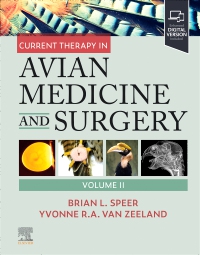
Current Therapy in Avian Medicine and Surgery Volume II, 1st Edition
Hardcover

-
- With the exception of updates on relevant, current topics, the information presented in this volume predominantly includes material not previously covered in the first volume.
- The many photographs, illustrations and comprehensive tables included in this volume visually highlight key concepts of current avian practice standards.
- Sections on pediatrics, falconry, toucans and hornbills feature specific topics which are less comprehensively included in most references.
- Focused sections on the respiratory system, the beak and skull, feathers, and feet offer detailed information on these particular anatomical regions.
- Pharmacologic intervention and options are explored in-depth to allow for clinicians to gain an optimal understanding of how to best develop treatment plans for their patients.
- NEW! An eBook version is included with print purchase. The eBook allows you to access all of the text, figures and references, with the ability to search, customize your content, make notes and highlights, and have content read aloud.
- Current Therapy format provides up-to-date information about patient management of specific disorders, including innovations in therapy and the pros and cons of proposed treatments.
- Coverage of a wide variety of bird species includes psittacines, pigeons, raptors, ratites, waterfowl, gallinaceous birds, and less common species.
- More than 800 full-color images depict avian disease conditions, show management strategies and thought processes, and aid in formulating guidelines to care.
- Summary tables simplify the lookup of key facts and treatment guidelines.
- Appendices provide quick access to a current drug formulary, normal biological data, clinical pathologic reference ranges, and growth and feeding charts of neonatal birds.
-
Section 1: Advances in Practice Management 1. Practice Management: Developing a Career as an Avian Veterinarian Section 2: Establishing a Diagnosis 2. Common Imaging Modalities: Selecting the Right Modality and Getting the Most Out of Your Imaging 3. Thermal Imaging 4. The Value of Necropsy Section 3: Therapeutic Intervention 5. Pharmacologic Intervention 6. Antimicrobial Agents 7. Antibacterial Drugs 8. Antifungal Therapy 9. Antiparasitic Drugs 10. Antiviral Drugs Section 4: Infectious Disease Prevention 11. Interaction of Host, Agent, Environment, and Disease 12. Hygiene and Disinfection 13. Vaccination Strategies Section 5: Updates on Infectious Diseases 14. Avian Bornavirus 15. Poxvirus 16. West Nile Virus and Other Flaviviruses 17. Campylobacteriosis 18. Chlamydiosis 19. Erysipelas In Wild Birds 20. Mycoplasmosis 21. Cryptococcosis 22. Trichomoniasis 23. Diplomonad Protozoal Diseases: Giardiasis, Spironucleosis 24. Histomoniasis 25. Cochlosomosis Section 6: The Respiratory System 26. Respiratory Anatomy and Physiology 27. Diagnostic Work-Up of Respiratory Problems 28. Diseases of the Respiratory Tract 29. Surgery of the Respiratory Tract 30. Diagnostic Endoscopy, Endoscope-Assisted Therapy, and Endosurgery of the Avian Respiratory System Section 7: Beaks, Feathers, and Feet 31. The Beak: Form, Function, and Problems 32. Feathers and Conditions of the Plumage 33. Pododermatitis Section 8: The Trauma Patient 34. Triage and Stabilization 35. Pain Management Updates 36. Wound Management 37. Fracture Management Section 9: Embryology, Neonatology, and Pediatrics 38. From Fertilization to Hatch: Egg and Embryonic Development 39. Natural Incubation 40. Artificial Incubation 41. Pediatrics 42. Raptor Incubation and Pediatrics 43. Incubation and Pediatrics of Columbiformes 44. Toucan Neonatology and Pediatrics 45. Neonatology of Precocial Birds Section 10: Advances in Welfare 46. Minimizing Stress and Fear During the Physical Examination 47. Strategic Use of Enrichment: What, When, and How Section 11: Conservation and Wildlife Management 48. Anthropogenic and Environmental Threats to Avian Wildlife: Introduction 49. Biotoxins 50. Hazards Related to Man-Made Structures: Buildings, Noise, Electric Power 51. Petroleum Products 52. Anthropogenic Toxins 53. Wildfires 54. Wild Birds, Cats, and One Health Section 12: Medicine of Specific Taxonomic Groups 55. Falconry: Past, Present, and Future 56. Toucans, Hornbills, Aracaris Appendices Appendix 1. Table of Common Drugs and Approximate Doses Appendix 2. Normal Clinical Pathologic Data Appendix 3. Normal Biological Data Appendix 4. Chick Growth Data